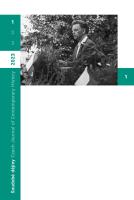"Hadrář" Prahy dvacátého století?
A "Ragman" of Prague of the Twentieth Century?
Cultural History as a Postmodern Fresco
Author(s): Veronika KošnarováSubject(s): History, Cultural history, Architecture, Local History / Microhistory, Czech Literature, French Literature, Interwar Period (1920 - 1939), Post-War period (1950 - 1989), Book-Review, History of Art
Published by: AV ČR - Akademie věd České republiky - Ústav pro soudobé dějiny
Keywords: Prague;Czechoslovakia;Czech culture;Czech literature;Czech art;surrealism;avant-garde;Czechoslovak-French relations;cultural history
Summary/Abstract: The book entitled "Praha, hlavní město dvacátého století: Surrealistická historie" is a Czech translation of the original English edition "Prague, Capital of the Twentieth Century: A Surrealist History" (Princeton – Oxford, Princeton University Press 2013) by British-Canadian cultural historian Derek Sayer. It deals with a number of events, phenomena and figures from the artistic and cultural history of Prague and the Bohemian lands from the late nineteenth to the second half of the twentieth century, with a special focus on the interwar period. The reviewer is primarily concerned with the author’s method. Sayer, she argues, takes inspiration from the methods of the German philosopher and sociologist Walter Benjamin (1892–1940), and in the style of montage and collage (as a “ragman of memory”, as Benjamin himself put it) freely transitions between different time periods, fields of art and culture, and the perspectives from which he examines the phenomena under study. The surrealist movement from the book’s title is only one of the topics which reveal the author’s predilection for the myth-making genius loci of “magical Prague”, in the spirit of the Italian writer and Bohemianist, Angelo Maria Ripellino (1923–1978). But Sayer does not equal Ripellino in poetic quality. In terms of the scope and diversity of the facts and events discussed, Sayer’s book is a monumental achievement, but the reviewer points to methodological problems in the handling of literary texts, a limited knowledge of Czech scholarly literature and a sensationalizing tendency. What is innovative about the book is not the point of view or the facts presented, but their arrangement, which represents a postmodern way of writing about cultural history.
Journal: Soudobé Dějiny
- Issue Year: XXX/2023
- Issue No: 1
- Page Range: 223-233
- Page Count: 11
- Language: Czech

